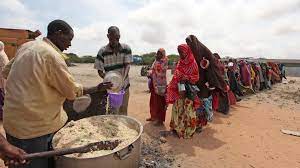After the Horn of Africa’s worst drought in decades, a UN food security report considers Somalia at severe risk of officially falling into famine in the coming months due to five consecutive failed rainy seasons and “exceptionally high” food prices. Some 700,000 people in several parts of the country are deemed at risk of suffering famine by between April and June next year after aid workers warned that funds diverted away towards the Ukraine conflict have hit the country hard. Islamic Relief country director Aliow Mohamed explained many citizens from particularly impoverished areas have been forced to walk hundreds of kilometers to major cities hoping for assistance, which government officials have been accused of ignoring for fear of tarnishing the country’s image as a failed state.
Today, these hard-learned lessons have failed to hold. For over a year, there has been a sustained early warning of a new drought and its consequences for the Horn of Africa. However, those warnings have yet to trigger a response that matches the scale of need. If urgent actions are not taken, history is set to repeat itself on an even larger scale. This does not have to be the case. Lives and livelihoods can still be saved.
Experts know what works: adequate empirical evidence shows that early action, relief, and social safety programs, especially Emergency Cash Transfers, save lives and livelihoods and offer dignity to those in need. National safety net programs can be used to prevent the acute impact of food insecurity and, in the medium term, a path to longer-term poverty reduction. Somalia, Ethiopia, and Kenya each have social safety programs designed precisely for situations like this. These systems have worked during past droughts. Donors, humanitarian agencies, and national governments should therefore view social safety programs as the connective tissue that links humanitarian aid and development.
In Somalia and Ethiopia, internal conflicts are the chief barrier to delivering humanitarian aid. In 2011, humanitarian groups feared falling afoul of the sweeping counter-terrorism regimes, and Al-Shabaab’s onerous and arbitrary requirement to program in the areas under their control inhibited humanitarian access in southern Somalia. Initially, most areas that experienced famine were predominantly areas under Al-Shabaab’s control, although it spread to the government-controlled areas later. Today, Al-Shabaab does not control as many areas as in 2011. However, between 700,000 and 900,000 people still live in regions controlled by the group, making humanitarian access difficult.
Ethiopia has historically suffered from chronic food insecurity, and the government has addressed some of its causes through the Productive Safety Net Programme (PSNP). The absence of large-scale conflict has also helped. But the outbreak of conflict in late 2020 between the Tigray authority on one side and the Federal Ethiopian government, the Eritrean military, and various militia on the other side has diverted resources towards the war and weakened community resilience. The federal government’s humanitarian blockade has also denied people in need of aid. Additionally, the killing of humanitarian workers and looting of humanitarian aid by parties to the conflict has exacerbated the already perilous situation.
The length and severity of droughts in the Horn of Africa are increasing. However, experts know how to address drought, and the 2017-2018 drought response offered a workable template. Early response, sufficient timely funding, and a combination of humanitarian aid and social safety nets save lives. Regional leaders must heed these lessons, starting with convening a regional summit to sound the alarm and take urgent action to address the ongoing crisis and halt the avoidable cycle of suffering.



